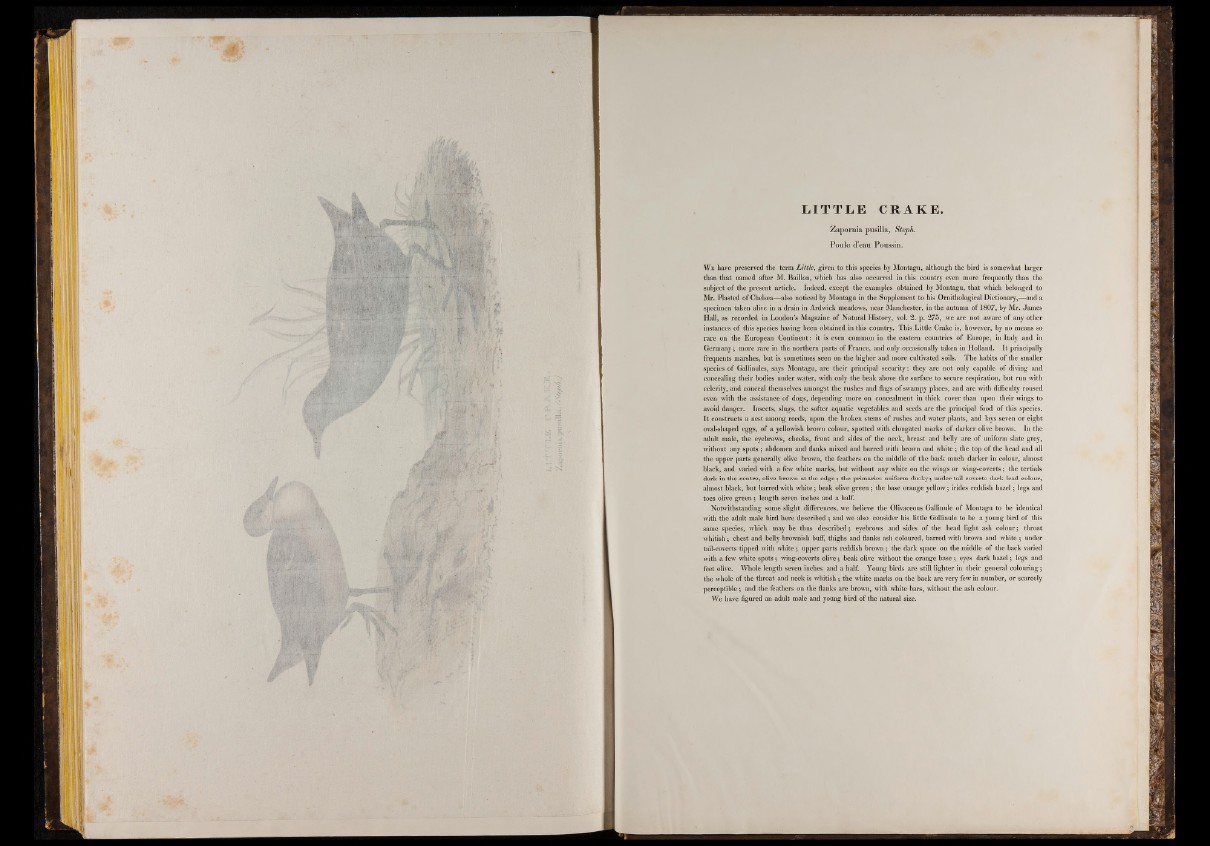
E I T T L E CRAKE .
Z a p o rn ia pusilla, S tep h .
Poule d’eau Poussin.
We have preserved the term L ittle , given to this species by Montagu, although the bird is somewhat larger
than that named after M. Bâillon, which has also occurred in this country even more frequently than the
subject o f the present article. Indeed, except the examples obtained by Montagu, that which belonged to
Mr. Plasted o f Chelsea— also noticed by Montagu in the Supplement to his Ornithological Dictionary,— and a
specimen taken alive in a drain in Ardwick meadows, near Manchester, in the autumn o f 1807, by Mr. James
Hall, as recorded in Loudon’s Magazine o f Natural History, vol. 2. p. 275, we are not aware o f any other
instances o f this species having been obtained in this country. This Little Crake is, however, by no means so
rare on the European Continent : it is even common in the eastern countries o f Europe, in Italy and in
Germany ; more rare in the northern parts o f France, and only occasionally taken in Holland. It principally
frequents marshes, but is sometimes seen on the higher and more cultivated soils. The habits o f the smaller
species o f Gallinules, says Montagu, are their principal security : they are not only capable o f diving and
concealing their bodies under water, with only the beak above the surface to secure respiration, but run with
celerity, and conceal themselves amongst the rushes and flags o f swampy places, and are with difficulty roused
even with the assistance of dogs, depending more on concealment in thick cover than upon their wings to
avoid danger. Insects, slugs, the softer aquatic vegetables and seeds are the principal food o f this species.
It constructs a nest among reeds, upon the broken stems o f rushes and water plants, and lays seven or eight
oval-shaped eggs, o f a yellowish brown colour, spotted with elongated marks o f darker olive brown. In the
adult male, the eyebrows, cheeks, front and sides o f the neck, breast and belly are o f uniform slate grey,
without any spots ; abdomen and flanks mixed and barred with brown and white ; the top o f the head and all
the upper parts generally olive brown, the feathers on the middle o f the back much darker in colour, almost
black, and varied with a few white marks, but without any white on the wings or wing-coverts ; the tertials
dark in the centre, olive brown at the edge ; the primaries uniform dusky ; under tail-coverts dark lead colour,
almost black, but barred with white ; beak olive green ; the base orange yellow ; irides reddish hazel ; legs and
toes olive green ; length seven inches and a half.
Notwithstanding some slight differences, we believe the Olivaceous Gallinule o f Montagu to be identical
with the adult male bird here described ; and we also consider his little Gallinule to be a young bird o f this
same species, which may be thus described ; eyebrows and sides o f the head light ash colour ; throat
whitish ; chest and belly brownish buff, thighs and flanks ash coloured, barred with brown and white ; under
tail-coverts tipped with white ; upper parts reddish brown ; the dark space on the middle o f the back varied
with a few white spots ; wing-coverts olive ; beak olive without the orange base ; eyes dark hazel ; legs and
feet olive. Whole length seven inches and a half. Young birds are still lighter in their general colouring ;
the whole o f the throat and neck is whitish ; the white marks on the back are very few in number, or scarcely
perceptible ; and the feathers on the flanks are brown, with white bars, without the ash colour.
We have figured an adult male and young bird o f the natural size.